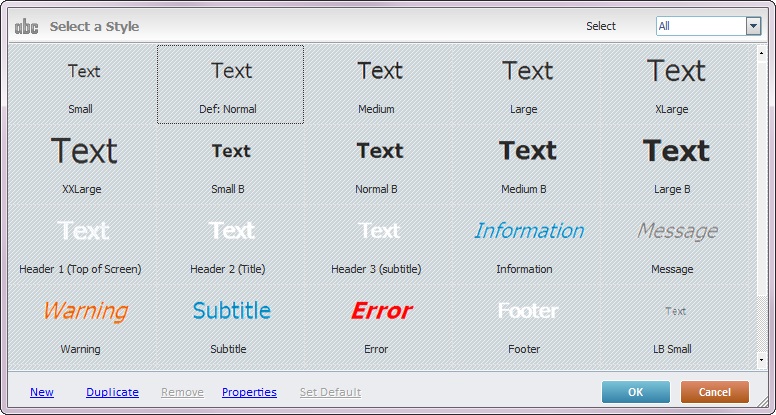Editing and Creating Styles
Overview
There are several standard styles to select from for each control in the “Control” tab.
When a control is selected in the "Control" tab, the Style Preview section (directly below) displays the several standard styles available for that control as well as any new styles you create.
If the control is dragged from the "Control" tab onto the screen, use Option A to edit that style or create a new one.
If you select a style in the Style Preview section, use Option B. The Style Preview section includes the standard styles and the styles you create during project development (custom styles). The standard styles cannot be edited, their features are locked. You can, however, use them as a starting point to create a new style (by copying a standard style and, then, editing the copy into a custom style). The custom styles can be edited and, if necessary, removed from the project.
If you want to modify the style of a control that is already on the screen into a standard style (from the Style Preview section), use Option C.
The styles of a control (standard and custom) can be viewed in the Style Preview section of the "Control" tab and in the corresponding "Select a Style" window.

Details of the "Select a Style" window
|
It is possible to filter the displayed styles. Select one of the following options from the drop-down: All – Displays all the styles available. Internal – Displays MCL-Designer V4's standard styles. Custom – Displays the styles you have created. |
|
Opens a “Style Properties” window to create a new style. |
|
Duplicates the selected style. It also enables the edition of the duplicated style in the “Style Properties” window. |
|
Only removes a custom style (a style you have created). |
|
Opens a “Style Properties” window, but only the styles you have created (custom) can be modified/edited. |
Sets the selected style as the default style for that control type ("Def:" is added to the style's designation). Once set, the default style will be adopted by the same type controls dragged from the “Control” tab onto the screen (ex: If you select "Text Normal" as the default style, all Display Text controls that are added afterward adopt the "Text Normal" style). |
To edit and/or create styles, use one of the following options:
Option A
After placing a control onto the screen (Drag-and-Drop) from the “Control” tab, right-click that control and select the “Change Style” option from the resulting menu. This provides access to a window, which displays the existing styles (standard and custom) and enables you to select, create and/or edit a new style.
To define a different style for the selected control:
a. double-click one of the styles available in the "Select a Style" window.
OR
b. Select the intended style and, then, click ![]() .
.
To create a new style, click ![]() (located at the bottom of that window) to open the "Style Properties" window where you can create a new style.
(located at the bottom of that window) to open the "Style Properties" window where you can create a new style.
To edit custom styles, click ![]() OR after the control's "drag-and-drop", right-click the control and, in the resulting menu, select the "properties" option. This leads to the "properties" window. Go to the "Layout" tab and click
OR after the control's "drag-and-drop", right-click the control and, in the resulting menu, select the "properties" option. This leads to the "properties" window. Go to the "Layout" tab and click ![]() to access a window with the existing styles. After reaching this window, select the "New" option and, in doing so, open the "Style Properties" window, where you can create a new style.
to access a window with the existing styles. After reaching this window, select the "New" option and, in doing so, open the "Style Properties" window, where you can create a new style.
Option B
Right-click a style displayed in the Style Preview section (located below the “Control” tab). This opens a menu list with the following options:
|
New |
Opens the “Style Properties” window to create a new style. |
Duplicate |
Duplicates the selected style and enables its edition in the “Style Properties” window. |
|
Edit |
Opens a “Style Properties” window to display the selected style’s properties. |
|
Remove |
Option only available if you select a custom style (standard styles cannot be removed). |
|
Set as default |
Defines the selected style as the default style for any control that is “dragged” from the “Control” tab on to the screen. |
Select the "New" option and open the "Style Properties" window. To create the new style, fill in the various options available in the menu.
Option C
This option can only be used for controls that have already been dragged onto the screen.
Drag the preferred standard style from the Style Preview section (located below the “Control” tab) and drop it on top of the control you want to modify. The control will automatically adopt the new style.
![]()
Only the styles you create can be edited. The other styles (standard styles)included in MCL-Designer V4 have their features locked (the ![]() is displayed on the upper right corner of their "Style Properties" window) and cannot be edited/deleted. You can only view their properties. This results in the activation/deactivation of certain options.
is displayed on the upper right corner of their "Style Properties" window) and cannot be edited/deleted. You can only view their properties. This results in the activation/deactivation of certain options.
![]() Each control has its own properties and, therefore, different options in the “Style Properties” window to select from.
Each control has its own properties and, therefore, different options in the “Style Properties” window to select from.
As a result, each control will have a separate topic detailing its style possibilities.